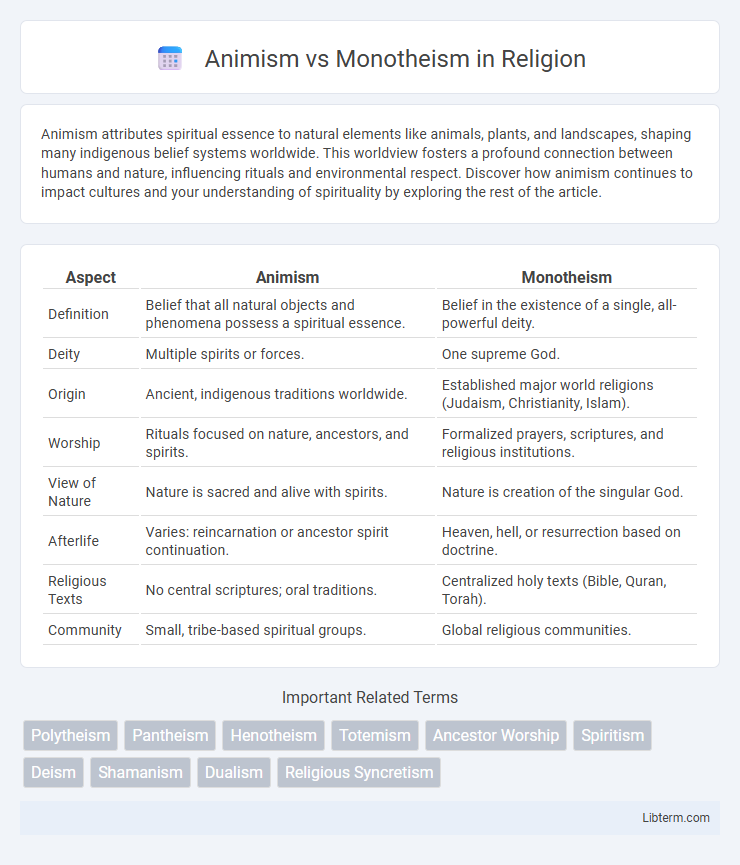Animism attributes spiritual essence to natural elements like animals, plants, and landscapes, shaping many indigenous belief systems worldwide. This worldview fosters a profound connection between humans and nature, influencing rituals and environmental respect. Discover how animism continues to impact cultures and your understanding of spirituality by exploring the rest of the article.
Table of Comparison
| Aspect | Animism | Monotheism |
|---|---|---|
| Definition | Belief that all natural objects and phenomena possess a spiritual essence. | Belief in the existence of a single, all-powerful deity. |
| Deity | Multiple spirits or forces. | One supreme God. |
| Origin | Ancient, indigenous traditions worldwide. | Established major world religions (Judaism, Christianity, Islam). |
| Worship | Rituals focused on nature, ancestors, and spirits. | Formalized prayers, scriptures, and religious institutions. |
| View of Nature | Nature is sacred and alive with spirits. | Nature is creation of the singular God. |
| Afterlife | Varies: reincarnation or ancestor spirit continuation. | Heaven, hell, or resurrection based on doctrine. |
| Religious Texts | No central scriptures; oral traditions. | Centralized holy texts (Bible, Quran, Torah). |
| Community | Small, tribe-based spiritual groups. | Global religious communities. |
Defining Animism: The Spirit in All Things
Animism defines spirituality as the belief that all elements in nature--trees, rivers, animals, and rocks--possess a living spirit or consciousness. This worldview contrasts with monotheism, which centers on a single, omnipotent deity governing the universe. By recognizing a spirit in all things, animism fosters a deep interconnectedness between humans and the natural environment.
Monotheism Explained: The One Supreme Deity
Monotheism centers on the belief in a single, all-powerful Supreme Deity who governs the universe with omniscience and omnipotence. This religion emphasizes a unified divine authority, contrasting animism's belief in multiple spirits inhabiting natural phenomena. Key monotheistic faiths include Christianity, Islam, and Judaism, each recognizing one transcendent God responsible for creation, morality, and cosmic order.
Historical Origins and Evolution
Animism traces back to prehistoric times, characterized by the belief that spirits inhabit natural elements, shaping early human interactions with the environment. Monotheism originated in the ancient Near East, particularly within the Hebrew tradition, evolving into major world religions like Judaism, Christianity, and Islam through codified scriptures and centralized worship of a single deity. The transition from animistic practices to monotheistic systems reflects shifts in social complexity, theological abstraction, and institutional authority over millennia.
Core Beliefs and Worldviews
Animism centers on the belief that spirits inhabit natural objects, animals, and places, emphasizing a spiritual interconnectedness between humans and the environment, while monotheism asserts the existence of a single, all-powerful deity who governs the universe. Animistic worldviews promote harmony with nature and ancestral reverence, contrasting with monotheistic frameworks that often prioritize divine law, moral codes, and salvation through a singular God. The core belief in animism is spirit presence within all entities, whereas monotheism hinges on exclusive worship and obedience to one supreme deity.
Sacred Practices and Rituals
Animism involves sacred practices centered on communication with spirits inhabiting natural objects, featuring rituals like offerings, trance dances, and ancestor worship to maintain harmony with the environment. Monotheism focuses on worshiping a singular, omnipotent deity through structured rituals such as prayer, sacraments, and ceremonies that reinforce moral codes and divine authority. While animistic rituals emphasize reciprocal relationships with multiple spiritual beings, monotheistic practices prioritize devotion and obedience to one supreme God.
Relationship with Nature
Animism perceives nature as imbued with spiritual essence, fostering a reciprocal relationship where humans actively engage with and honor natural entities. Monotheism often views nature as a creation governed by a singular deity, positioning humans as stewards with responsibilities toward preserving and managing the environment. This fundamental difference shapes diverse ethical frameworks and approaches to ecological balance in indigenous versus monotheistic belief systems.
Role of Ancestors and Spirits
Animism centers on the belief that ancestors and spirits actively influence the physical world, with rituals and offerings sustaining their presence and guidance. Monotheism typically recognizes a single, omnipotent deity, while ancestor and spirit worship is often secondary or symbolic, emphasizing reverence rather than direct interaction. The role of ancestors in animism is integral to daily life and community well-being, contrasting with the more hierarchical and doctrinal focus seen in monotheistic traditions.
Ethical Frameworks and Moral Codes
Animism centers ethical frameworks on harmonious relationships with nature and spirits, emphasizing respect, reciprocity, and communal well-being. Monotheism establishes moral codes derived from divine commandments, promoting concepts of justice, obedience, and accountability to a singular God. Both systems guide human behavior through distinct spiritual principles shaping societal norms and personal conduct.
Societal Impact and Cultural Expressions
Animism fosters communal rituals deeply connected to nature, promoting a collective identity centered around ancestral spirits and natural forces, which often manifests in storytelling, art, and ceremonies that reinforce social cohesion. Monotheism typically centralizes moral codes and societal laws derived from a single divine authority, influencing political structures and cultural norms through organized religion, scriptural teachings, and institutional worship. These differing worldviews shape cultural expressions by either emphasizing harmonious living with the environment in animism or prioritizing ethical monotheistic doctrines that impact law, education, and art within society.
Modern Perspectives and Contemporary Relevance
Modern perspectives highlight animism as a worldview emphasizing interconnectedness between humans, nature, and spiritual entities, contrasting with monotheism's focus on a singular, transcendent deity. Contemporary relevance of animism is evident in ecological movements and indigenous rights, promoting environmental stewardship and cultural preservation, while monotheism continues shaping global ethics, law, and social norms through established religious institutions. Both belief systems influence modern spirituality and ethical frameworks, reflecting ongoing dialogues about the sacred, identity, and humanity's place in the cosmos.
Animism Infographic

 libterm.com
libterm.com